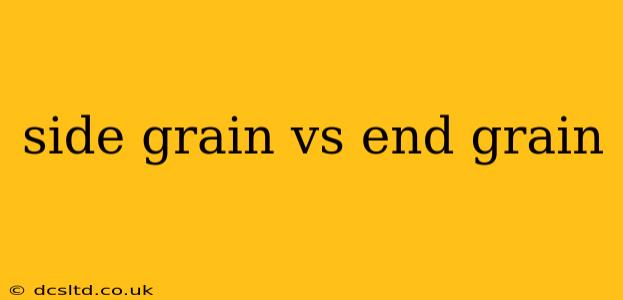Choosing the right type of wood for your project depends on several factors, and understanding the difference between side grain and end grain is crucial. This seemingly small detail significantly impacts the wood's properties, durability, and overall suitability for various applications. This comprehensive guide will explore the key distinctions between side grain and end grain wood, helping you make informed decisions for your woodworking endeavors.
What is Side Grain Wood?
Side grain, also known as plain-sawn or flat-sawn, refers to wood where the cut is parallel to the long axis of the tree trunk. Imagine slicing a log lengthwise; the resulting surface is side grain. The growth rings in side grain wood appear as lines running roughly parallel to the surface.
Characteristics of Side Grain:
- Appearance: Displays prominent growth rings and a more varied texture.
- Strength: Generally less strong than end grain, particularly in terms of edge strength.
- Workability: Relatively easy to work with, making it suitable for various woodworking techniques.
- Cost: Typically less expensive than end grain.
- Stability: Can be more prone to warping and cupping over time due to moisture changes.
Common Uses of Side Grain:
Side grain is a versatile choice used extensively in furniture making (tables, chairs, cabinets), flooring, paneling, and general construction. Its ease of workability and affordability make it a popular choice for a wide array of projects.
What is End Grain Wood?
End grain wood is cut perpendicular to the growth rings of the tree. Imagine looking directly at the end of a tree stump; that's the end grain surface. The growth rings appear as concentric circles on the end grain.
Characteristics of End Grain:
- Appearance: Shows growth rings as concentric circles, creating a unique and visually appealing texture.
- Strength: Exceptionally strong and durable, especially when subjected to pressure.
- Workability: Can be more challenging to work with than side grain, requiring specialized tools and techniques.
- Cost: Usually more expensive than side grain due to the increased material waste and specialized processing.
- Stability: Extremely stable and resistant to warping and shrinking, provided it's properly finished.
Common Uses of End Grain:
End grain’s exceptional durability makes it ideal for applications requiring high impact resistance and wear tolerance. Common uses include cutting boards, butcher block countertops, and high-traffic flooring. Its unique visual appeal also makes it popular for artistic projects and decorative elements.
Side Grain vs. End Grain: A Comparison Table
| Feature | Side Grain | End Grain |
|---|---|---|
| Cut Orientation | Parallel to growth rings | Perpendicular to growth rings |
| Appearance | Parallel grain lines | Concentric circles |
| Strength | Less strong | Extremely strong |
| Workability | Easy | More challenging |
| Stability | Less stable | Very stable |
| Cost | Less expensive | More expensive |
Which is Better: Side Grain or End Grain?
There isn't a definitive "better" choice between side grain and end grain. The optimal selection depends entirely on the intended application and desired properties. Consider the project's requirements for strength, durability, aesthetic appeal, and budget when making your decision.
How to Identify Side Grain vs. End Grain?
Identifying the grain type is straightforward. Look closely at the wood surface:
- Side Grain: Growth rings run parallel to the surface.
- End Grain: Growth rings appear as concentric circles.
Frequently Asked Questions (FAQs)
What is the difference between rift sawn and quarter sawn wood?
Rift sawn and quarter sawn are both methods of sawing lumber that produce a more stable and visually appealing product compared to plain-sawn (side grain). They produce a straight grain appearance, reducing the chances of warping. The key difference lies in the angle of the cut relative to the growth rings. Quarter sawn results in a more consistent grain pattern than rift sawn.
Can I use side grain for a cutting board?
While possible, side grain is not ideal for cutting boards. Its lower density and greater susceptibility to damage make end grain a far superior choice for this application.
Which grain is best for furniture?
Both side grain and end grain find applications in furniture making. Side grain is more common due to its workability and cost-effectiveness. However, end grain may be preferred for high-stress areas or for specific aesthetic effects.
Is end-grain wood more expensive?
Yes, end-grain wood is generally more expensive than side-grain wood due to the higher material waste and more specialized milling techniques required.
By understanding the nuances of side grain and end grain, you'll be better equipped to select the perfect wood for your next project, ensuring both functionality and aesthetic excellence. Remember to always consider the specific demands of your project to make the most informed decision.
